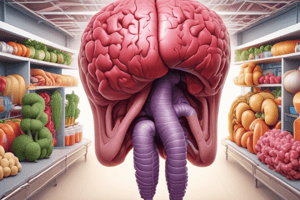Podcast
Questions and Answers
איזה אחד מהבאים אינו חלק ממערכת העיכול?
איזה אחד מהבאים אינו חלק ממערכת העיכול?
- המעי הגס
- הכבד
- הלבלב
- הריאות (correct)
מהי הפונקציה העיקרית של מערכת העיכול?
מהי הפונקציה העיקרית של מערכת העיכול?
- לפרק מולקולות גדולות למרכיבים קטנים יותר (correct)
- לסלק פסולת מהגוף
- לספק חמצן לגוף
- לייצר אנרגיה לגוף
איזה אחד מהבאים אינו חלק מהצינור העיכול (מערכת העיכול העילית)?
איזה אחד מהבאים אינו חלק מהצינור העיכול (מערכת העיכול העילית)?
- הוושט
- הפה
- הכליות (correct)
- המעי הדק
מהו הסדר הנכון של האיברים במערכת העיכול העילית?
מהו הסדר הנכון של האיברים במערכת העיכול העילית?
איזה תפקיד ממלאים האיברים הסולידיים כמו הכבד, הלבלב והבלוטת הלבנה במערכת העיכול?
איזה תפקיד ממלאים האיברים הסולידיים כמו הכבד, הלבלב והבלוטת הלבנה במערכת העיכול?
מה הקשר בין נוטריינטים למערכת העיכול?
מה הקשר בין נוטריינטים למערכת העיכול?
מה תפקיד הלעיסה והריר במהלך עיכול המזון בפה?
מה תפקיד הלעיסה והריר במהלך עיכול המזון בפה?
מה תפקיד החומצה ההידרוכלורית והפפסין בקיבה?
מה תפקיד החומצה ההידרוכלורית והפפסין בקיבה?
מה תפקיד התריסריון והמעי הדק?
מה תפקיד התריסריון והמעי הדק?
מה תפקיד הלבלב במערכת העיכול?
מה תפקיד הלבלב במערכת העיכול?
מהי החשיבות של ספיגת חומרי התזונה ממערכת העיכול לגוף?
מהי החשיבות של ספיגת חומרי התזונה ממערכת העיכול לגוף?
איזה תהליך במערכת העיכול מניע את תנועת המזון לאורך הצינור העיכול?
איזה תהליך במערכת העיכול מניע את תנועת המזון לאורך הצינור העיכול?
Flashcards are hidden until you start studying
Study Notes
The Digestive System: Your Body's Nutrient Processing Machine
The digestive system is a complex network of organs and processes that transform the foods and drinks we consume into essential nutrients. It is made up of the gastrointestinal tract, which includes the hollow organs from the mouth to the anus, and the solid organs like the liver, pancreas, and gallbladder. Let's dive deeper into understanding the structure, function, and importance of this intricate system.
An Overview of the Digestive System
The digestive system is designed to break down large molecules found in food and drink into smaller components called nutrients. These nutrients, such as proteins, fats, carbohydrates, vitamins, minerals, and water, serve as the building blocks necessary for maintaining optimal health and carrying out bodily functions.
The digestive system consists of two primary components: the gastrointestinal (GI) tract and the accessory organs. The GI tract, often referred to as the alimentary canal, is a hollow tube extending from the mouth to the anus. It comprises the following organs in sequence: mouth, esophagus, stomach, small intestine, and large intestine. Accessory organs include the liver, pancreas, and gallbladder, which support the operation of the GI tract and aid in specific aspects of digestion.
The Journey of Food Through the Digestive System
Consumption begins in the mouth, where food is chewed and mixed with saliva containing salivary amylase, an enzyme that starts the breakdown of carbohydrates. Swallowing initiates peristalsis, a wave-like contraction of the esophageal muscles that propels the food toward the stomach. Upon entering the stomach, the mixture is churned and mixed with gastric juices, including hydrochloric acid and pepsin, to further break down proteins and denature carbohydrates.
Next, the partially digested contents pass through a sphincter into the small intestine, where the duodenum receives additional digestive juices from the pancreas and bile from the liver via the hepatopancreatic ampulla. The small intestine is lined with tiny finger-like projections called villi and microvilli, which increase the surface area for efficient absorption of nutrients.
As the nutrient-rich chyme progresses through the small intestine, the jejunum and ileum absorb glucose, amino acids, and other nutrients into the bloodstream. The remaining waste material is transported to the large intestine, where the majority of water reabsorption occurs.
Water, electrolytes, and some nutrients passively diffuse across the mucosa and are absorbed into the portal vein, which carries them to the liver for further processing and distribution throughout the body. The undigested waste residue, now transformed into stool, accumulates in the rectum before being eliminated from the body through defecation.
The Importance of the Digestive System
The digestive system serves several crucial functions beyond the mechanical and chemical breakdown of food:
-
Absorption: The small intestine efficiently extracts essential nutrients from the chyme, making them available for use by cells and tissues throughout the body.
-
Energy Production: The liver converts consumed carbohydrates into glucose, which serves as the primary source of energy for the body.
-
Excretion: Though primarily a method for waste removal, the digestive system indirectly contributes to overall excretion by expelling unnecessary fibrous materials from food and filtering out toxins from the liver.
In conclusion, the digestive system plays a vital role in sustaining life by converting the foods and liquids we consume into usable nutrients. Its intricate design ensures the efficient extraction and utilization of vital nutrients, enabling our bodies to function optimally.
Studying That Suits You
Use AI to generate personalized quizzes and flashcards to suit your learning preferences.




